Last year, we posted our picks for the best ski mountaineering trip reports from North America in the 2013/2014 season. We decided to do it again this year with the following criteria: a well written report with exciting photos and true ski mountaineering, not just ski touring.
While last year was marked by a series of exciting reports on FKTs in North America, this year that front was much quieter. Instead, we have a handful of cool trip reports to take your mind off the unbearable summer heat.

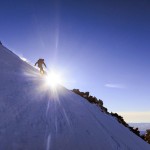
Next up is a report from our Utah friends, the Dorais brothers. Jason and Andy have been fixtures on the skimo racing podiums in the US and have also been stepping up their game in big mountain terrain. After returning from the Ski Mountaineering World Championships in Switzerland, along with Tom Goth, another top US skimo racer, they ticked off the Teton Trifecta in excellent style. A technically demanding series of descents, presented with words from Andy and excellent photos from the group here.
Also be sure to check out the recent film documenting the Dorais bro’s approach to life and skiing by Duct Tape Then Beer Productions at the end of this post.
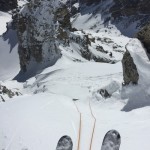

Another report is from Noah Howell, formerly of Powderwhore Productions, is well versed in story telling and generally an impressive photographer. While he may look a rather unlikely skimo racer, he seems to be one of the few who truly race for the fun of it. When he isn’t racing skinny skis on the North American series, he seems to have an affinity for getting a little further afield than most of us and embracing the suffering that accompanies such trips. His report from a spring trip to the Beartooth Mountains is illustrative of this approach to technical ski mountaineering descents.
Last up, not a specific trip report but a blog to follow for its beautiful pictures and excellent beta if you find yourself skiing in the Cooke City area, the Cook City Chronicle by Beau Fredlund.
And that should be enough reading to stoke the excitement for winter! 🙂
If you have any other awesome trip reports that you think must be included, link them in the comments below!
Jason Dorais
Dec 1-7 News Shorts: US Skimo Team qualifiers, Vert180 in Canada, Bernier's big November, Jornet readying for Aconcagua
With a new season under way, we are going to continue the weekly roundups that you got used to last winter but we are going away from the “Skimo Racing Roundup” name and will be calling it “News Shorts” as there are often other ski mountaineering related items worth including besides just skimo racing. We believe you will enjoy this format even more!
US Skimo Team qualifiers: Gaston continues winning
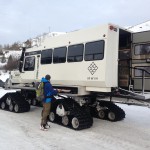

In the women’s race, Lindsay Plant (2014 NA Teams Race Champion with Janelle Smiley) stayed in the lead throughout the race with seemingly little competition. Sari Anderson and Jessie Young (new to the skimo circuit but quickly improving) equalled each other on the first climb. Anderson dropped out of the race and Young chased hard forcing Plant to increase her pace to maintain her lead. Nikki LaRochelle finished in third.
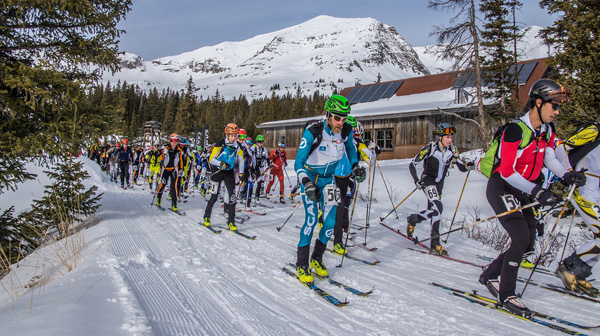

SkinTrack’s Eric Carter, who is trying to qualify for the US Worlds Team, placed 9th on Saturday and 5th on Sunday. Eric was happy with the results despite seeing room for improvement. His altitude acclimatization program seemed to work (he lives at 14 m in Squamish, Canada) and all the hard dry land training is paying off.
» Weekend results from both races – https://www.facebook.com/USSkimo/posts/795269280519181
» Great weekend race photos can be found here.
» Qualifying criteria and process can be found on USSMA website here.
Vert180 opens season in Canada
In Canada, the Vert180 in Calgary opened the skimo racing season with its unusual format once again. The winner of the men’s category, trail runner and skimo racer Travis Brown, climbed a little less than 3000 m in 180 minutes of racing. Second and third went to Peter Knight and Ryan Burlingame respectively. The women’s category win went to Kylee Toth, who is coming back strongly after having two kids in the last several years! Michelle Roberts and Marg Fedyna finished second and third.
» Vert180 results are here.
Melanie Bernier’s big November
Melanie Bernier is the only Canadian, and only the second North American, to place on a skimo World Cup podium and as part of her preparations for the World Championship season she went on to do a massive month of training. She accumulated over 70,000 vertical meters during November in the mountains around Revelstoke and in Rogers Pass. Once again, Melanie will travel to Europe for an extensive period of time this winter and we can’t wait to see what exciting performances she will be up to this season.
Kilian Jornet ready for Aconcagua speed attempt
If you haven’t caught the news yet then next couple of weeks will bring another speed record attempt by Kilian Jornet. Like Melanie, he also did lot’s of training in November and, only few days ago, left France for South America. None of such records are guaranteed but if the weather on Aconcagua is at least somewhat cooperative, then Jornet should be able to set the bar very high for anyone that will come after him.
Wolf Creek skimo race on Nov 22
The first race on the USSMA calendar went down two weeks ago at the Wolf Creek ski area in Colorado. Men’s category top 3 were: Scott Simmons, Jon Brown, Pete Swenson. In women’s race category, the win went to Lindsay Plant, followed by Sarah Stubbe and Christena Ward.
» Full results are here.
Teaser video for 2015 Ski Mountaineering World Championships in Verbier
Interview with Tom Goth – the 2014 US SkiMo National Champion – on inspiration, training and gear
 Few weeks ago, I was trying to figure out who to approach for the next SkinTrack’s interview when I thought of Tom Goth.
Few weeks ago, I was trying to figure out who to approach for the next SkinTrack’s interview when I thought of Tom Goth.
I thought of him because I didn’t think our North American skimo community knew much about him – he seems to keep more private than others – yet he was quietly collecting podium placings over the last two seasons.
Fast-forward few weeks and, what a coincidence, Tom became the US National Ski Mountaineering Champion in individual race on March 15th at Crested Butte.
He is 28, is a member of the US National SkiMo Team and La Sportiva athlete living in Salt Lake City, UT.
Tom Goth on his background and inspiration

Before discovering skimo racing, I was a resort skier who dabbled in ski touring for a while. Despite its appeal to me, it never really took hold until 2010/11. That’s when I had a parking lot run-in with skimo evangelist, Andy Dorais.
After the seed was planted it has been a progression in gear acquisition, increasing training and racing. It’s become my main sporting focus during the year.
Q: What inspired you to start racing in this sport? What do you like the most about it?
Skimo shares the attributes of other endurance sports, something which has always appealed to me. As a lifelong skier, it was a natural decision to pick up the sport as I became aware of it.
Often skimo is referred to as a complete sport – aerobic capacity on the climbs, strength and power on the descent and technical ability with transitions. I think this is true, but for me the real gravy is that training is so much fun. Squeezing in few thousand vertical after work, something which would have seemed like half-day tour a few years ago, feels like freedom.

I did some competitive running in high school and college, but didn’t take training very seriously. One obstacle to consistent training was my passion for skiing. After college, I picked up triathlon during the summers. I learned some discipline and put together improved results, including a top ten Ironman finish and two trips to Kona.
To focus on skimo, I’ve taken a break from long course triathlons. I’ve moved the cycling and running off-road to get more vertical in the summer.
On training and becoming faster
Q: I would say that you had a pretty fast rise up the US skimo ranks, by the way, congrats on becoming the US SkiMo National Champion a month ago! What do you think were the most crucial elements and factors that allowed you to develop so quickly?
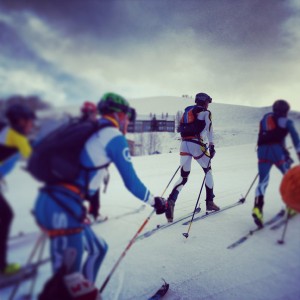
I think with any endurance sport, the most important aspect of training is consistency. I’ve been lucky enough to put together consistent training this season and over the past couple years. Across all sports, my progression as an endurance athlete has been very linear.
With regards to skimo, my biggest leaps have been with sport specific skills, such as descending and transitions. It may sound obvious, but the best way to get better at descending on race skis is to train on race skis. Many of us have more desirable skis to take out on any given day, but if you embrace the skinny skis it pays off in races.
Q: You raced in Europe and attended the SkiMo World Champs for the first time last year. What was your experience like? What surprised you the most? And what did you find different?
Racing in Europe was awesome. The depth of field, the perfect skin tracks, the long climbs and descents, and the atmosphere in general made for a great experience.
Glide. I was most surprised by the amount of glide some of those guys were getting. Whether it was on the flats or the low angle climbs, their technique and skins allowed them to move really fast!
I think with ISMF sanctioned races in the US our courses are continuing to improve. However, the courses at world champs were impressive. There was no hacking straight up a mogul field. It helped that they had an army (literally) putting in the double track.

This season 2013/14 looks like:
- October – December: Uphill running and early season skiing
- December – March: Competitive skimo season (20 – 40k vertical ft and 15 – 25 hours / week)
- March – May: Spring adventure skiing
- April – September: Mountain bike, trail run and some swimming (10 – 20 hrs / week)
Q: Do you do any strength training? If so, is it skimo specific or more general?
No weight training during the competitive season. I may include some during the off season. Downhill running is also something I rely on during the off season.
Q: Do you have a coach?
No, I don’t.
Q: What are your future skimo racing and athletic goals?
For next year, it’s to race well at the World Championships in Verbier. It would be great to make another trip for one of the Big Three as well.

On nutrition and gear
Q: Do you follow any specific diet? (vegetarian, Paleo, LCHF…)
I find it hard to subscribe to any dietary dogma, but I do like the Paleo and LCHF ideas. I fuel my training and racing with typical sports nutrition, but generally eat whole unprocessed foods for meals.
Q: What race gear have you been using this season?
La Sportiva RSR skis, Stratos Cube boots, RSR bindings and multiple brands of skins. The La Sportiva partnership has worked out great. Going from not racing on their gear to getting my best results has been a huge validation for me. I’m stoked on their products.

16 ounce soft flask(s).
Q: If you could ask anyone from the whole world skimo racing community one question, who would it be and what would you ask?
That’s a hard question! But right now I’m geeking out on gear, so I’d love to check out the production process of the La Sportiva Cubes. Hopefully soon there are more full carbon race boots than plastic on the market.
Q: For all SkinTrack reader’s that ask me whether I am obsessed with skimo racing poles length, here’s my signature question: How tall are you and long are your poles? 🙂
6’2” (188 cm) and 140 cm.
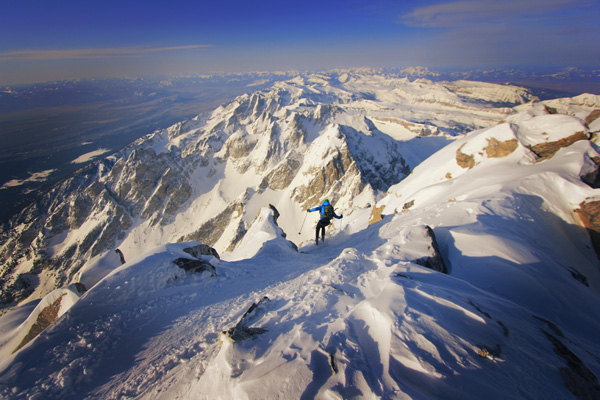
Best 6 Ski Mountaineering Reported Trips of 2012-2013 "season"
The other day, on Twitter, Carl (@CarlKohnstamm) asked me for my opinion on “What are the top 5 ski mountaineering trip (reports) of 2012-13”? (It was worded a bit differently but after clarification that is what he meant.)
That is a one damn great question – fun to answer but by no means it’s easy. Here I am going to attempt to best express my opinion while approaching the question from a wider perspective, and obviously taking into account only trips that I know of.
Note: FKT stands for “fastest known time”
1. Matterhorn FKT (2h 52min) – by Kilian Jornet

Why I included it? Because it was realized by arguably the best skimo racer ever. Kilian “ran” from Cervinia, Italy (around 2,050 m) to the top of Matterhorn (4,478 m) in 1h 56min, which was an ascent speed of 1,256 m per hour!
He descented back in 56min which was a descent speed of 2601 m/h – that is almost like skiing!
» One of the various reports from this “trip” can be found on Climbing.com – http://www.climbing.com/news/kilian-jornet-shatters-matterhorn-speed-record/
2. Mount Rainier FKT – by Jason and Andy Dorais

Besides, Mt Rainer is almost 4,400 m high (14,411 feet) and the route up it definitely includes enough hazard negotiation that one cannot just go without thinking. Skiing it down fast is also quite dangerous.
This is also the one performance of 2013 that pisses me off the most as Dorais brothers stole the record from our team only about 10 days after Eric Carter and Nick Elson pushed their old one down to 4h 19min. 🙂
» Report by Jason from their attempt – http://jasondorais.blogspot.ca/2013/06/mt-rainier-speed-run-35755.html
» Report from our trip – http://www.skintrack.com/trip-reports-conditions/mount-rainier-record-4h-19min-12sec/
3. Steep descents in Coast Mountains – by Tevor Hunt
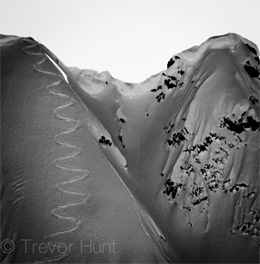
This is a superb read of a solo descent of a steep face on an undisclosed peak not too far from civilization in the Coast Mountains of BC.
But this one is only one of many under-the-radar (1st) descents of the little known steeps hunter Trevor Hunt.
(Interview with Trevor coming soon!)
» Read “Full Commitment” here http://www.coaststeepskier.com/wphome/?p=21242
4. Tantalus Traverse in a day (FKT) – by Skyler Des Roches, Christian Veenstra

A fitting quote from their day:
“Crossing above above a nunatak, then literally sprinting below a fierce cracked serac cave, we made our way along another bench between crevasses until we reached a notch on the south shoulder of Dione.”
» Here’s the full account of this 17h day – http://runoutoffroute.wordpress.com/2013/05/22/tantalus-traverse-in-a-day/
5. Spearhead Traverse 2 x FKT – by Eric Carter, Nick Elson, Brad Schalles
Spearhead Traverse has been testing grounds for Coastal speedy ski mountaineers for a long time. The tradition was likely started by no other than Greg Hill back in 2004 or so on the classic version (Blackcomb to Whistler Village via Singing Pass).

This spring three of my good friends took on these records with great success:
First, Eric and Nick lowered Greg Hill’s classic version of the traverse record from 4h to 3h 10min
http://coastmountainskiing.com/race-spearhead-traverse-fkt/
Then couple of weeks later, Brad Schalles called me to investigate the route I took in 2009 on the long version to make sure he stayed on it as close as possible. He pushed the time down to 6h 47min! No report but Brad’s blog is here – http://westcoastskimo.blogspot.ca/
6. Steep skiing on Mount Robson – by Reiner Thoni and Jeff Colvin
 Reiner and Jeff are my good friends from which I have learnt a great deal whether about mountains or just life in general. I was happy to see that after over a year of not seeing each other they were able to hook up for such an adventure this summer.
Reiner and Jeff are my good friends from which I have learnt a great deal whether about mountains or just life in general. I was happy to see that after over a year of not seeing each other they were able to hook up for such an adventure this summer.
By now, Reiner knows Robson very intimately – summitted it about 5 times and skied it twice in last 2 years – yet this must have been a highly rated trip up a familiar mountain.
For those that don’t know Reiner – he is consistently highest placed North American at skimo world champs and placed 15th at Pierra Menta last March. But his big heart mostly beats for things outside of racing.
Eye candy
I left videos out of the above list on purpose. Because if you are like me then I didn’t want you to get caught up in a spectacle and forget about priorities. And you are welcome 🙂
Here’s a short clip of Kilian’s record on Matterhorn.
Reiner’s and Jeff’s skimo adventure on Robson.
Honorable mention
This didn’t make it to the list as it has nothing to do with ski mountaineering but what a performance and inspiration – Ueli Steck speed soloing South Face on Annapurna this October. More at Alpinist – http://www.alpinist.com/doc/web13f/newswire-ueli-steck-south-face-annapurna
Exclusive interview with Max Taam and John Gaston: On training, gear and life with a team that dominated the 2013 US skimo racing circuit
There must have been very few people in the skimo racing community that would have picked Max Taam and John Gaston to dominate last season’s (2012/13) American racing circuit the way they did.

On top of their domination in the US they also achieved a historic finish for North American men at World Championships (not including relay race results). They finished 10th in teams race at the 2013 Worlds in France! Previous NA best was a 16th place by Canadian’s Reiner Thoni and Andrew McNab in teams race in 2011.
So that’s who we are talking to today 😉
Q: Let’s start from the beginning: When did you start racing ski mountaineering?
Max: My first race was the Aspen Highlands Inferno in 2006. The race goes up the boot-pack on Highlands ridge and down the center of the bowl. A year or two after this I started doing a few of the Colorado Ski Mountaineering Cup races (COSMIC).
John: 2008 Aspen Highlands Inferno was my first uphill/downhill ski race. At the time I couldn’t believe how fast Mike Kloser was compared to everyone else, so I kind of made that my goal to win, which happened in 2010.
I was still very much a downhill-focused skier though at that point, and it wasn’t until 2012 that I finally started racing skimo. I skied myself of course and DNF’d my first race at Winter Park, then got a serious ass kicking a couple weeks later at the Teva Games in Vail. And then I was hooked.
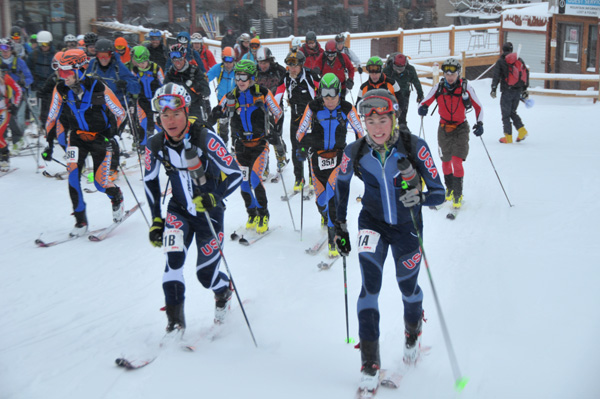
Max: I have done all sorts of endurance racing and skimo is definitely my favourite. I started with crew in high school and college, and since then have competed road biking, mountain biking, and trail running.
John: I grew up mountain biking, dirt biking, and skiing in New England. But I think like most kids I wasn’t really into the endurance side of these sports; I liked going downhill but hated climbing so much. It really wasn’t until right after graduating college that I started doing endurance sports for more than an hour at a time.
Q: What gear did you do your first skimo races on? Did you have very light gear right away?
Max: For my first Highlands inferno I was on Garmont Adrenaline boots and Stockli Stormrider DP alpine skis.
By the time I did my first real skimo races I had Scarpa F1 boots, Volkl Snowwolf skis, Dynafit Comfort bindings, and full length and width BD synthetic skins.
John: My first Highlands Inferno races were all done on full alpine gear – Full Tilt boots and 4FRNT EHP’s mounted with Salomon STH 16’s.
But for skimo I definitely had very light gear right off the bat. It wasn’t really a question for me whether it was worth the investment or if I was even going to like the sport. Having sat out nearly all of the 10/11 winter with a back injury and watched Max and my brother Pete getting more into skimo racing, I knew right away that that was going to be my sport. It just made sense, even though I’d never done it, and I wanted to be competitive right away.
Q: Max, I know you from previous racing seasons and World Champs in 2010 and 2011. You have been always fast but obviously you turned some switch to really dig into skimo. When did that happen?

Then having John around Aspen last winter definitely pushed me to get faster. The experience I have gained over my years of racing, have made me a smarted racer. I dramatically decreased the amount of meat in my diet at the start of last summer, which pretty quickly made me a few pounds lighter.
Q: When did you guys started to train together for ski mountaineering races?
John: Max and my brother Pete were training partners way before I came into the mix. He was over in Cham the 11/12 winter when I started racing, so it wasn’t until last season that we ever trained together.
Still, we do most of our training alone just due to schedules and what not. But it’s definitely really fun to have someone to motivate you if you’re not feeling it that day. But we didn’t really need to train a lot together to be good racing together – we knew we were very compatible for team racing.
Q: Where do you live and train?
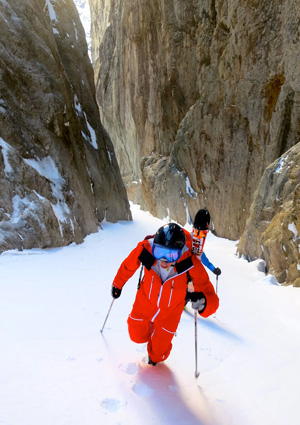
John: I live in Aspen, and Strafe’s office is right in the Highlands base village, so most of my training is done around Ajax and Highlands.
Q: Do you have any sponsors or do you work to support your racing?
Max: I work as a ski patroller on Aspen Mountain. I also have a number of sponsors that make a big difference in my success: Strafe Outerwear, SCARPA, Ski Trab, Oakley, Aspen/Snowmass, Honey Stinger, and POC.
John: I work for STRAFE Outerwear designing and developing some sweet outerwear, but I’m lucky to have a pretty flexible schedule, which means as long as I am efficient I get to ski almost every day.
This sport ain’t cheap and none of the racing would be possible without great support from STRAFE, Oakley, Scarpa, Ski Trab, Honey Stinger, POC, Aspen/Snowmass, and the Aspen Brewing Company. Thanks guys!
Q: You guys are both great skiers. What gear did you race on last season (skis, bindings, boots)? Any changes for this year?
Max: Last year I raced on Dynafit boots, Dynafit bindings, and Atomic skis. This year I will be racing on SCARPA Alien 1.0 boots, Ski Trab TR Race binding, and the Ski Trab Gara Aero World Cup ski.
I love equipment that I don’t have to hold back on, on the descents. I have been skiing in the SCARPA Alien 1.0 since March and have been very impressed.
The first pair of race skis I had were made by Ski Trab and I was amazed at how durable they were and how well they skied, so I am really excited to go back to them. I am also really looking forward to touring and training on the Ski Trab Magico ski.
» Check out the comparison pages for what Max will be racing on this year – lightest boots, skis, bindings.
John: Last year I was on Dynafit boots and binders, and Atomic skis, but I’m really stoked to try out Scarpa Aliens 1.0 this year. They weigh the same as the Evo’s but the walk mode is ridiculous. I weigh a bit more than a lot of racers too so I’m definitely excited for the stiffer support they offer on the downhill.
I’ll also be on Ski Trab Gara Aero World Cup skis and TR Race bindings. It’s pretty cool to be on the same equipment used by the majority of top world cup racers over in Europe.
Q: John, you won all three US qualifying races for the 2013 World Champs, including the Nationals at Jackson. Were you surprised? What did it change or confirm for you?
John: I was a little surprised. I knew I had an outside shot, but there are so many variables in skimo that can and do go wrong all the time.
I didn’t have a lot of racing experience under my belt but what I did have was very helpful. I mean the 2012 Power of Four was one of the most brutal races anyone had ever experienced, so that alone gave me confidence that if I kept my cool I could get a good result.
But to follow up Nationals with 3 more race wins in a week (there was a Highlands town series race on Thursday before Sunlight), that was really cool. In the past it didn’t seem like there were consistent winners, so to train and prepare and work out the details to try and minimize all those variable factors, and then see it really work, and work well, was great.

Max: I typically struggle to find my speed for the first month of the season. I was really excited to find it by the end of January and maintain it through the end of the season. Worlds were definitely my biggest goal, and finishing 10th in the teams race with John was the highlight.
Q: So let’s talk about the 10th place at 2013 Worlds then. I label it as a superb result! How was that day? What were your hardest moments?
Max: We were pretty slow on the first climb, because I usually struggle early on, especially at lower altitudes. We were probably in 25th or so at the top of the first climb. From the first descent to the finish we continuously made up ground both skiing and climbing.
John and I are usually some of the faster skiers, which always makes things more fun.
John: That day was hard! I felt great from the gun, but kind of over did it on the first climb and felt pretty bad the rest of the race. It was just slow and steady after that I really just had to follow Max’s heels for the middle climbs. Not my best feelings on the up, but we were cruising on the descents, passing a lot of teams and having a blast.
I also really liked the downhill ridge running section and the crampon section. That was my first time racing with crampons and it definitely made it way more interesting. But I was totally blown by the final skate and really happy to see the finishing chute!
» Here’s a short report from that day.

Max: I really like the individual race, even though it’s usually a bit short for me. As with the teams race I fell back early on, but made up ground during the second half of the race. I didn’t have a great sprint race, but it’s something I would like to do some specific training for in the future.
John: The individual race was definitely my favourite, mainly because the course was still really cool, and I just felt and raced a lot better. It started off just crazy fast, and the intensity stayed so high the whole time. I know the 31st place isn’t nearly as impressive sounding as the 10th from teams, but I was really proud of that.
And the relay was way more exciting than I was expecting. I didn’t think too much of it beforehand since it was a ten-minute effort, but that was some of the most pain I have ever experienced in my life.
Everything about the Worlds is really incredible if you’re coming from the grassroots American scene. The courses, the fans, the atmosphere – all of it is next level!
Q: Do you plan on racing team races together in the future?
Max: Yes, I feel like our skills complement each other really well.
John: For sure. I think we work very well together, and it’s especially nice to be the same speed on the descents. Climbs are one thing – if someone’s going faster you can tow and vice versa, but that’s not possible on descents and it would suck to have to hold back.

Max: I raced the Pierra Menta in 2012 with Pete Gaston, John’s brother. I would love to go back and race it again.
John: I would love to race the Pierra Menta.
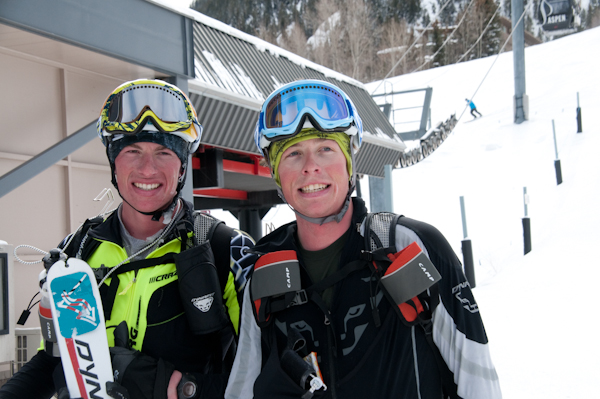
Max: I spent September in France guiding road bike trips for Cycle the Alps. My friends Liz and Miles Smart, who are mountain guides in Chamonix, France, started the company, and I am excited to be apart of it. This years trips brought me to some incredible places and were a great few weeks of high volume training.
John: I actually wasn’t over there this summer – my brother Pete was guiding mountain bike trips over there so maybe you were thinking of him! 😉
I did take a trip over in the Fall though to go to Oktoberfest! I love Europe though and definitely plan on spending more time over there in the future.
Q: How do you train in the summer? Do you also race?
Max: I used to do a lot of bike racing. Since I started focusing more on skimo a few years ago, I reduced my summer racing to a select few mountain biking and trail running races.
John: Summer is all about mtb racing. I end up racing the same amount summer and winter.
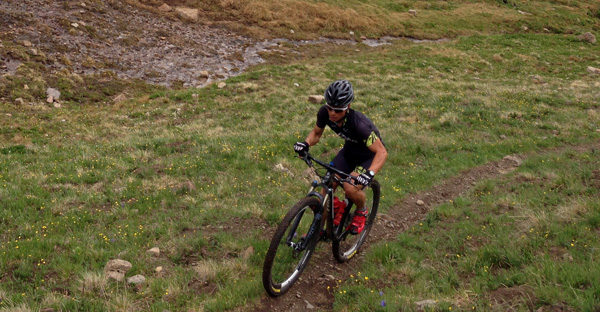
Q: What does your racing calendar looks like for this season, only US races or will you visit foreign countries as well?
Max: I am excited about our growing US schedule, in particular the 3 ISMF sanctioned races in the US. I would love to race in Europe again this winter, if the opportunity arises. I would really like to make it up to Canada sometime to race as well.
John: Not totally sure yet. I’m not going to start racing until January, when it’s Jackson/Targhee/Sunlight time. I’d love to go to Europe and race some World Cups after that, but I think Pierra Menta may take priority. And I guess it’s about time Max and I give the Grand Traverse a go, even though the race itself doesn’t really appeal to me from a skiing standpoint.
Q: Do you have any goals in the backcountry? Descents, traverses…?
Max: I would like to do some big traverses in Colorado. It’s a pretty new thing for Colorado. We don’t always have the right conditions, but when we do, I think some epic days are possible.
John: I want to get more comfortable in bigger, more technical mountains. That’s always been a weak point of mine, as I have zero climbing background. That pretty much means following Pete and Max around on their objectives and trying not to kill myself.

Max: I really like to preview courses. This allows me to know exactly what I have coming up on every climb and to ski the descents faster with more confidence.
John: I think eating and drinking is really important in any race over an hour. Maybe it’s because a lot of racers come from running backgrounds, where apparently starving yourself is the norm, but most skimo racers don’t eat or drink nearly enough to sustain their level of intensity.
For downhill, I think people who spend most of their time in the backcountry should vary it up and ski the resort once in awhile. Ski Areas allow you to ski much harder, steeper terrain in a wider variety of conditions, at faster speeds, more often.
Q: How would you advise an absolute skimo racing novice to start besides just jumping into a race? Give me three most important things in order of priority.
Max:
- Focus on good skinning technique. You can beat far fitter people, with good technique.
- Practice a few transitions before the race. They don’t need to be perfect, but this will help you relax in the transitions.
- Be familiar with the course and race format, so that there are no big surprises.
John:
- Make sure you have comfortable boots! Nothing turns people off from skinning like massive blisters.
- Build up some solid base fitness. Racing is more fun when it doesn’t feel like you’re dying the whole time.
- Go touring with friends, preferably some that have a little racing experience. You’ll learn basic race technique in a way more fun and casual manner.
» For more skimo tips check out this article – 10 Quick Tips to Improve Your Skimo Racing
Q: A bit off topic now: What did you wanted to be when you were 15? And what do you want to be now?
Max: When I was 15, I knew that I loved skiing. Now, I get to spend most of my day on skis!
John: I wanted to be pro big mountain skier. I think that was the year MSP’s Ski Movie 3 came out. Seth Morrison was the coolest skier in the world (still is), and Hugo Harrison had just come onto the scene, skiing faster and harder than anyone. I wanted to do what they did. I guess I still do, but now I have this endurance itch that needs scratching, and sometimes gets in the way of the more fun aspects of the sport!
2012 North American Rando Ski Mountaineering Championships in Crested Butte
This is article was submitted by Melanie Bernier – an elite skimo racer and a member of the Canadian National Ski Mountaineering Team. Read her previous article here – Grand Teton: adventures are essential for skimo training…
Last weekend (Jan 28-29, 2012) saw the biggest event of this winter on the North American skimo racing calendar. Six of us, part of the Canadian National Team, traveled to Crested Butte to compete in the first ever official North American Championships.
We arrived few days earlier to have a chance to get somewhat used to CB’s high elevation (CB is at 2,715 m) and explore the race routes. The “No Climbing Uphill Policy” at the ski hill got in the way of our course scoping but we were blessed with beautiful sunny days so we were able to at least have a great visual of the individual’s race course.
Sprint race – day 1
On Saturday morning, we woke up to a very brisk -30 C for the sprint race. The venue was mid-mountain near a beautiful restaurant where racers gathered to keep warm until the start.
The course started on a flat groomed sections changing quickly to switch-backs in the trees then flatter terrain before gaining the first transition to the first descent. Through gates, over moguls, racers had to zigzag back down for a second transition. Then to a short boot-pack and skin again to reach the final descent.
The women were the first out of the gate going at 30 seconds intervals. Sari Anderson was the first one to go, I was second, Janelle Smiley just after…
My race went very well as I closed the gap on Sari at the top of the second climb and completed the course in 5:39 which was enough to win the race.
Top 3, top North American and all Canadian women:
1. Mel Bernier (CAN)
2. Janelle Smile (USA)
3. Sari Anderson (USA)
6. Julie Matteau (CAN)
Our Canadian men did very well too! With a strong Italian presence, the Canuck boys rose to the challenge. Manfred Reichegger (Italy’s top racer) topped the podium as expected. Behind him, our unique “Reinerian” earned second ahead of Lorenzo Holzknecht (Italy) who was followed closely by our Andrew McNab. It was very impressive to see them all run and give all they had.
Top 3, top North Americans and all Canadian men:
1. Manfred Reichegger (ITA)
2. Reiner Thoni (CAN)
3. Lorenzo Holzknecht (ITA)
4. Andrew McNab (CAN)
5. Jan Koles (USA)
6. Travis Scheefer (USA)
12. Ian Gale (CAN)
27. Steve Sellers (CAN)
» Sprint race full results
Individual race – day 2
The following day, in friendlier temperatures, we gathered at the base of the mountain for the individual race. The course was not so impressive for its vertical but for its challenging route.
We climbed a groomed run for a thousand feet before getting into what seemed like 100 switch-backs with a single skin track. From there, it was skis and poles on the pack, jacket on, and via-ferrata and ascender on the rope – we climbed the “Guides Ridge” to the summit of Crested Butte at just over 12 000 feet.
From there, we ran down the other side of the peak, then skis on, we descended to the bottom of Paradise Bowl, from there we climbed 1000 through the trees and on the rocky ridge back to the top transition. We had to complete this same lower loop twice before going down a single track in trees, steep icy moguls to crazy fast groomer to moguls again and high speed rollers to finish with an excruciating skate ski.
My race – I guess my strategy was not quite right for this race. I was holding back at the start a bit too much and got stuck behind at the switch-backs. Then by the time I got to the ridge there was a big bottle neck.
Here the race got stopped twice because of rock falling and miss communication between the race marshals which resulted in an hour spent on the ridge getting cold and waiting to move forward at a turtle pace.
Fortunately, the view was pretty nice and people around me were friendly so it was quite pleasant and relaxing… but not much of a race at that point.
When finally at the summit, I literary sprinted down the bootpack and skied like mad to try to catch up. At the first lap up paradise bowl I left the transition way too fast and forgot that this was not a great idea while racing at such altitude – I burned myself solid for the second lap and I was barely hanging facing the “Bunk Wall”.
Finally at the top of the last climb, I knew I could gain some time and positions with a fast descent. Reaching the final section I completed the skate with below zero juice in the tank. It was a great learning experience as I have never (or not in a long time) reached such low energy levels while racing.
For few other Canadians the race went rather smoothly. Reiner Thoni and Andrew McNab escaped the bottle neck and had a fantastic race while the rest of us were still on the ridge those two were batteling for 3rd and 8th place respectively.
A big congratulation to our Continental Champs Reiner Thoni and Janelle Smiley.
Top 3, top North Americans and all Canadian women:
1. Janelle Smiley (USA)
2. Sari Andreson (USA)
3. Stevie Kremer (USA)
5. Melanie Bernier (CAN)
7. Julie Matteau (CAN)
Top 3, top North Americans and all Canadian men:
1. Manfred Reichegger (ITA)
2. Lorenzo Holzknecht (ITA)
3. Reiner Thoni (CAN)
4. Luke Nelson (USA)
5. Jason Dorais (USA)
8. Andrew McNab (CAN)
18. Ian Gale (CAN)
28. Steve Sellers (CAN)
» Individual race full results

